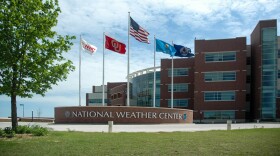Oklahoma is now No. 6 in the nation in wind-generated electricity capacity, and last week the state helped set a wind power record for the entire region.
Wind farms are multiplying and expanding in Oklahoma, Texas, Kansas, and throughout the Great Plains, where the nation’s wind energy potential is concentrated.
The industry’s growth is worrying weather forecasters because wind turbines can confuse radar.
The problem is the 150 foot-long blades spinning atop a wind turbine and the undulating, ominous clouds that accompany severe weather look the same to the computers that digest and display weather radar data, says Ed Ciardi, a meteorologist for the National Oceanic and Atmospheric Administration.
Ciardi, who works at NOAA’s Radar Operations Center in Norman, which controls all 158 of the country’s NEXRAD weather radar sites, pulls up a feed from a station near Frederick, Okla., in southwest Oklahoma. The screen shows a line of storms to the east, and what appears to be a storm cell to the west, just south of the Red River.

“They look like thunderstorms or strong rain showers,” Ciardi says, looking at his feed from the radar station.
The storm cell 12 miles north of Vernon, Texas is a ghost. It’s actually the Blue Summit Wind Energy Center, a wind farm that started operating in 2012.
This is not a new phenomenon; meteorologists and scientists have known about wind turbine interference for years. U.S. Department of Defense raised the issue in 2006 over concerns that wind projects might impair military radar.
“A weather radar works by sending out a pulse of radio energy. It bounces off raindrops, hailstones and so-forth, comes back and tells us something about the target and the speed,” says Robert Palmer, a professor and associate vice president for research at the University of Oklahoma’s School of Meteorology.
But because turbines are moving with the wind — the same wind that’s powering storms and weather systems — current radar technology can’t tell the difference.
SOLVING THE PROBLEM
There are two solutions to the problem, and both have complications.
One is to write new computer programs to filter out wind farm clutter, which Palmer has been working on for seven years.

“The algorithms we’re coming up with are really complex,” Palmer says. ”There are processors that are capable of doing it, they’re just not on the operational weather radars.”
Installing computers capable of running new filtering algorithms would require upgrading radar stations, a process that would include a lengthy field-testing process — in all, a time-consuming and expensive proposition for a federal agency facing uncertain budgets.
Another solution, says Ciardi with NOAA, is preventing wind farms from being built near weather radar stations. “But the wind resource happens to be right where the most severe weather occurs,” he says.
Wind farms are multiplying and expanding in Oklahoma, Texas, Kansas and throughout the Great Plains, where the nation’s wind energy potential is concentrated. Ciardi doesn’t think it’s going to be possible to keep all the turbines away.
The U.S. and state governments don’t have rules preventing wind operators from building near weather radar stations. NOAA is relying on the wind-energy industry to voluntarily submit new wind projects for the federal agency to review. “It’s been a pretty good working relationship, and so far we’ve had pretty good cooperation,” Ciardi says.
'CLUTTER' CONFUSION
There is some anecdotal evidence that wind farm radar clutter has impaired weather forecasts in the past, but Ciardi says it’s mostly a nuisance — right now. But more wind farms could mean more confusion.
“And that confusion will cause them probably to play on the safe side and issue more warnings than are necessary,” Ciardi says. “So we’d have increased false warning rate for severe weather."
Ciardi says false warnings train people to ignore forecasters. And when forecasters cry wolf, Oklahomans may stop paying attention, which can create a real danger in Tornado Alley.








